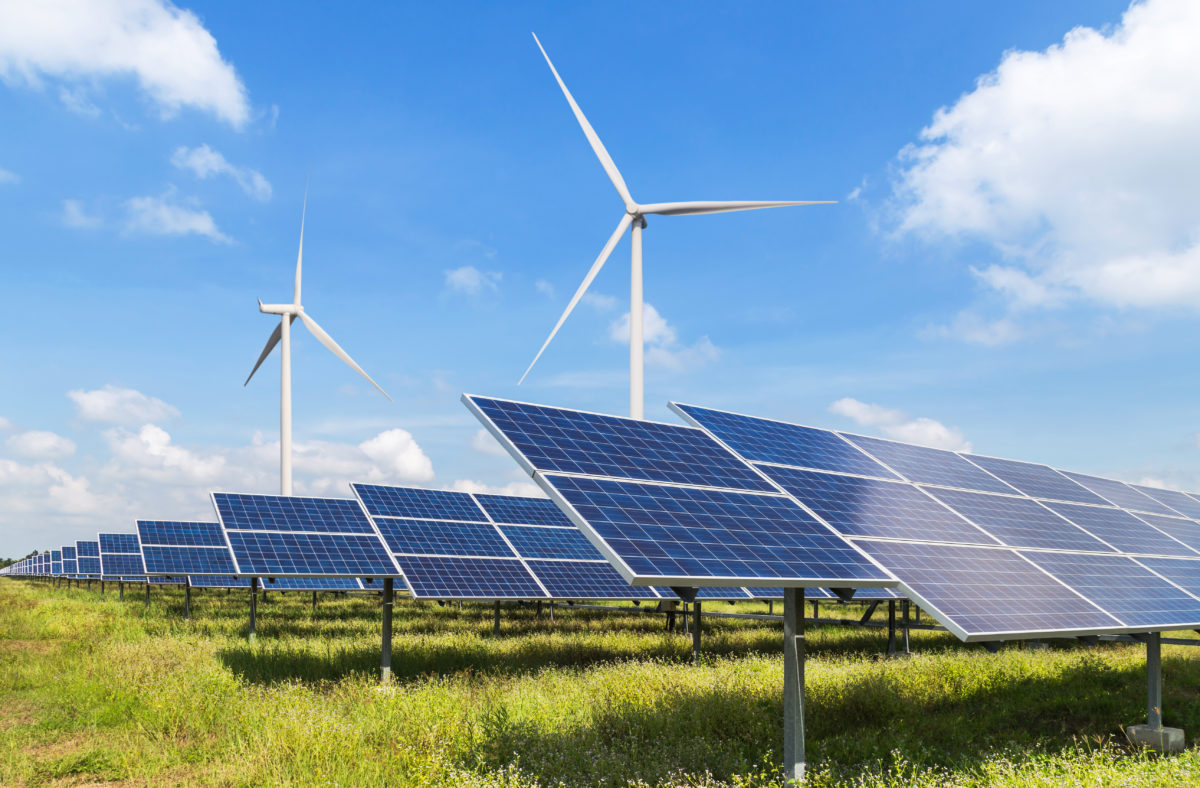The worldwide capacity for renewable energy increased 6% in 2021 reaching close to 295 GW, compared to 2020, where wind capacity addition dipped by 17%, offset by an increase in solar and hydropower installations. According to the International Energy Agency’s Renewable Energy Market Update of May 2022, this happened amidst several demand and supply shocks stemming from the global pandemic.
The addition to renewable capacities is expected to break records in 2022 with an 8% increase forecast, pushing through the 300 GW mark. In contrast to 2020, the global offshore wind installation is predicted to double despite China’s national policy phase-out deadline, while solar PV is forecast to break records in 2023, reaching 200 GW according to the IEA report. At the moment, China accounts for 46% of worldwide renewable capacity addition, followed by the European Union and the United States.
Solar and wind equipment manufacturers and suppliers are navigating a supply chain predicament made worse with countless bottlenecks. Prior to the global pandemic, new energy especially solar power, was gaining traction. However, in 2020 it dropped 64% to its lowest since 2010. From the first quarter of 2021, the renewable energy industry saw skyrocketing raw materials and shipping costs, equipment prices, increased import tariffs, new labor practices and other government regulations. By March 2022, the price of PV-grade polysilicon more than quadrupled, steel prices increased by 50%, copper rose by 70%, aluminum doubled and freight costs rose almost five-fold. Surging freight costs are the biggest contributor to overall price increases for onshore wind. For solar PV, the impact is more evenly divided among elevated prices for freight, polysilicon and metals.
Rising shipping costs and regulatory labor practices from China
China is one of the biggest manufacturers of new energy panels. In 2021, prices of shipping containers leaving from China, such as Shanghai, have increased roughly six-fold from its pre-pandemic baseline. This radical increase in prices could be attributed to the global pandemic where substantial shipments by sea were canceled; to date, even with the global economy opening up and resuming business as usual, the shipping industry is still on a long road to recovery.
Slower production of key photovoltaic components
In 2021, the photovoltaic industry saw its worst polysilicon shortage for the first time in 10 years. The popular demand for solar panels and wind turbines pre-pandemic caused manufacturers at various stages in the supply chain to enter the bullwhip effect, which occurs when a high level of orders are placed, thus sending a ripple effect through the supply chain. However, when the pandemic happened, these same manufacturers slammed the brakes and slowed or ceased production. When economic activity bounced back faster and better than expected, the demand for raw materials soared, and polysilicon miners and refiners struggled to catch up, sending prices skyrocketing.
These supply chain chokeholds have a ripple effect—as many market watchers would already know—and have exposed engineering, procurement and construction (EPC) industries, and developer firms to risks that threaten the success in commercial, industrial, and utility photovoltaic (PV) projects. Further compounding this is the pressure from federal legislators, who are adamant on implementing a “green” economic overhaul as quickly as they can—it has almost become akin to a race of “who has the most green energy production”.
Navigating the supply chain bottleneck with BASF
Will supply chain woes hamper the expansion of the photovoltaic and green industry? The simple answer is “no” but the complex answer is “yes, it will”. If organizations play their cards right, they could meet the demands quickly with the collaborative support of companies like BASF that develop a suite of photovoltaic new material solutions to enable businesses.
With the current supply disruptions, and even keeping in mind the possibility of future challenges, BASF sees the importance of creating solutions that are more sustainable and addresses the need for energy efficiency and conservation. With the company’s knowledge and expertise in chemistry for oilfields, refineries, mining, wind and solar energy, BASF partners with and enables customers through a commitment to a healthier, more natural, and more affordable future for energy and resources.
More from our partners
As the world's leading chemical company, BASF is involved in many aspects of the photovoltaic industry–from silicon ingots slicing to components of PV panel assembly to frame component fabrication. The BASF Creation Centers are anchored with sustainability in their language. Offering a broad selection of material competencies ranging from polyamide (PA), polyethylene-phthalate (PBT), polyoxymethylene (POM), thermoplastic polyurethane (TPU) and polyurethane (PU) systems, BASF prides itself on developing high performance products that are durable and improve efficiency.
With sustainability at the core of their developments, BASF’s integrated end-to-end PV Solar Solutions further support go-green initiatives for a brighter and green future. There are a wide variety of applications available such as Ultramid® FR (PA) for connectors and junction boxes or using Ultramid® (PA) and Ultradur® (PBT) for PV module, or even using Elastollan® (TPU) for cables and wires; the applications and possibilities ahead are endless.
Connectors and junction boxes using BASF’s Ultramid® FR (PA)
- Good chemical resistance
- Good processability
- Good hydrolysis resistance towards heat and humidity
- Fits to all standards and regulations (e.g., TUV, VDE, IEC, UL)
- Ease of use
- Measurable product performance
PV Module using BASF’s Ultramid® (PA) and Ultradur® (PBT)
- Reduces weight
- Resistance to corrosion
- Resistance to environmental factors such as humidity, ozone damage and microbes
- Very good flexural fatigue strength
- Easy assembly and installation
- Efficient to produce in large amounts
PV Module using BASF’s PU solution
- Design freedom
- Resistant to corrosion
- Good environmental resistance
- Good mechanical stability
- Good chemical resistance
- Low thermal expansion
- Easy to assemble and install
- CAE simulation
- Optimized design structure
Cables and Wires with BASF’s Elastollan® (TPU)
- Excellent low-temperature resistance and flexibility
- Good life span for wear and tear
- Good environmental resistance
- Excellent flexural fatigue strength
- Good color stability
- Abrasion resistance
Partnering with BASF ensures that there will be an end-to-end experience for companies in the photovoltaic industry because it develops its components at its own factories and laboratories. From the upstream manufacturing process to the downstream energy management process, BASF’s innovative and sustainable products cover most of the target applications.
 Nicholas Mok is a segment manager, Industrial, Performance Materials Asia Pacific, BASF. With over 14 years in plastic industry in sales, marketing, business development, he’s experienced in specialty plastics, commodity plastic, and engineering plastic. He has an in-depth knowledge in plastic processing techniques such as injection molding, compression molding, thermoforming, blow fill seal, blow molding, extrusion, foaming and has worked in several industries: semiconductors, medical, manufacturing, oil & gas, manufacturing, aerospace, transportation, solar, and printing.
Nicholas Mok is a segment manager, Industrial, Performance Materials Asia Pacific, BASF. With over 14 years in plastic industry in sales, marketing, business development, he’s experienced in specialty plastics, commodity plastic, and engineering plastic. He has an in-depth knowledge in plastic processing techniques such as injection molding, compression molding, thermoforming, blow fill seal, blow molding, extrusion, foaming and has worked in several industries: semiconductors, medical, manufacturing, oil & gas, manufacturing, aerospace, transportation, solar, and printing.
This content is protected by copyright and may not be reused. If you want to cooperate with us and would like to reuse some of our content, please contact: editors@pv-magazine.com.



By submitting this form you agree to pv magazine using your data for the purposes of publishing your comment.
Your personal data will only be disclosed or otherwise transmitted to third parties for the purposes of spam filtering or if this is necessary for technical maintenance of the website. Any other transfer to third parties will not take place unless this is justified on the basis of applicable data protection regulations or if pv magazine is legally obliged to do so.
You may revoke this consent at any time with effect for the future, in which case your personal data will be deleted immediately. Otherwise, your data will be deleted if pv magazine has processed your request or the purpose of data storage is fulfilled.
Further information on data privacy can be found in our Data Protection Policy.